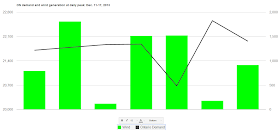It was a cold week which lead to demand being up over the comparable week in 2012 by 13.4% - which is the highest growth in years.
Weekly Ontario demand of 3,162,967 megawatt-hours is the highest demand this year.
Here's some lessons reinforced this week:
 even in winter. Wind had a very productive week, but on two of the seven days, including the highest winter peak, it was producing at under 10% of capacity.
even in winter. Wind had a very productive week, but on two of the seven days, including the highest winter peak, it was producing at under 10% of capacity.2. Ontario burns fossil fuels to generate electricity for export.
This is likely not intentional, but simply indicative that trade exists, and Ontario's natural gas generators are used to meet demand elsewhere.
I believe the projections in the long-term energy plan continue a trend of underestimating fossil fuel use by ignoring the export implications of current contract structures (net revenue requirements), and market operations.
3. Ontario is again not showing some exports.
Not long after I wrote Secret Deals between Public Power in Ontario and Quebec 2 years ago, the activity described there (feeding Saunders output directly into Quebec's high-voltage direct current, or HDVC, grid) hasn't seemed to occur as often. After the first 8 hours of this particularly week, the redirection was constant, averaging about 300MW each hour. [1]
A note on net exports to New York and Quebec to end.
Our export partners may not be importing to meet domestic consumption. Last week the price driver in the region was the New England's market; if you look at Ontario's trade with Quebec we become exporters during price spikes. The first spike in this graph accompanied prices over $300 in the ISO-NE market.
The ISO-NE received most of it's imported power from the NY-ISO and Quebec.
We would be wrong to assume exports to Quebec indicates Quebec requires to import electricity - it's likely far closer to the truth to say when they can buy at $40/MWh and sell at $150, they do.
Hopefully OPG received more than $40/MWh for switching over a portion of Sauders' production.
Endnote
[1] Many grey areas here, so it's not possible to give definitive figures.
My belief is that, in the IESO's Intertie Schedule and Flow Report, exports through PQ.B5D.B31L represent Saunders feeding into HQ's grid, and exports through PQ.Q4C represent the same situation at Chats Falls - however, Chats Falls is half owned by HQ (as I understand it).
The point is these exports do not show in the IESO's reported exports in their "Hourly Import Export Schedules" text files (market data files) or the daily, weekly and monthly summary reporting based on those text files, nor do they show as production (at Saunders or Chat Falls) - the existence of the Ontario production fed onto QC's grid only appear in the Intertie reporting.



773138FEFE
ReplyDeletekiralık hacker
hacker arıyorum
kiralık hacker
hacker arıyorum
belek
04BFE376FA
ReplyDeleteTakipçi Satın Al
M3u Listesi
Google Konum Ekleme
Eti Mutlu Kutu Kodları
101 Okey Vip Hediye Kodu